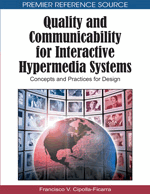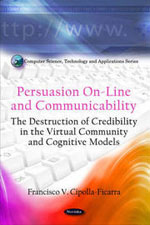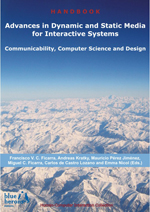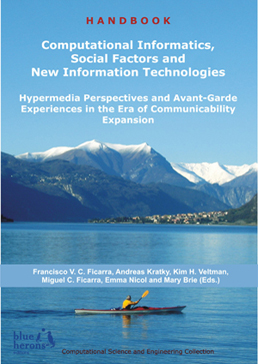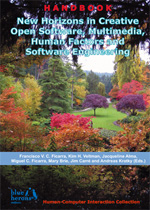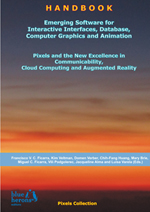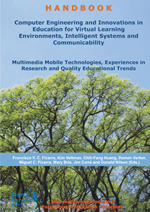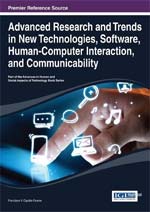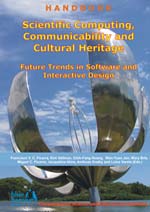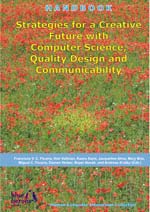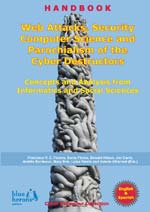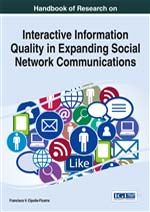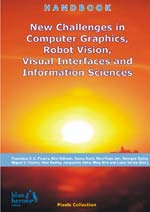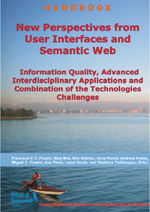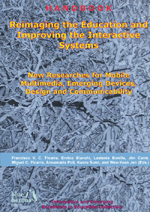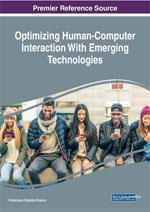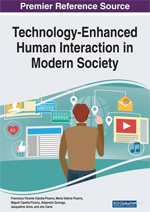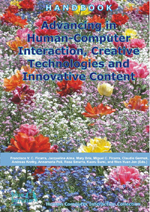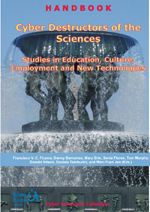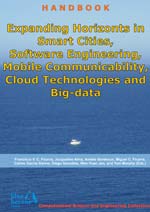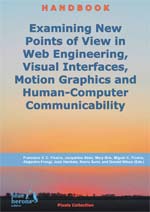Examining New Points of View in Web Engineering, Visual Interfaces, Motion Graphics and Human-Computer Communicability
:: Pixels Collection ::
:: Revised Selected Chapters ::
Main Editor: Francisco V. C. Ficarra
Co-editors: Jacqueline Alma (Vancouver, Canada), Mary Brie (La Valletta, Malta), Miguel C. Ficarra (Spain and Italy), Alejandro Frangi (Leeds, UK), José Hamkalo (Buenos Aires, Argentina), Kaoru Sumi (Hakodate, Japan), and Donald Nilson (Oslo, Norway)
Editorial Assistants: Jim Carré (Willemstad, Curaçao) and Luisa Varela (Perpignan, France)
Book Details
• ISBN: 978-88-96471-83-8 :: DOI: 10.978.8896471/838
• Publisher: Blue Herons Editions
• Location: Italy (Bg)
• Subjects: 3D, Web, CPU, Heuristic Analysis, Education, Information Retrieval, Culture, Arts
• Subjects: Computer Graphics, RAM, Comics, Claymation, Mobile, Matrix, WebRTC, RFID
• Subjects: Design, Communicability, Rendering, Creativity, Cross-platform, WebSocket, iTV
• Subjects: IoT, Pseudo-Feminism, Medical Imaging, G-Factor, Peltier, HCI, Unreal Engine 4
• Subjects: Smart Cities, 3D Slicer, PWM, Gait, Motion Capture Technology, New Media, UX
• Subjects: Computer Animation, Deep Learning, Software Engineering, Gamification, 2D, VR
• Subjects: Cinema 3D, Videogame, Automultiscopic Display, Information Architecture, NFC
• Subjects: R&D, Immersive Learning, Hypercube-like Networks, Motion Graphics, Semiotics
• Subjects: User Interfaces, AI, Delphi Technique, Context, Tourism, Factual, Social Science
• Subjects: Interaction, Audit, Human Factors, Quality, Computer Vision, Sociology, ICT, AR
• Subjects: Evaluation, e-Learning, Parochialism, Colonizers, Neo-colonized, Mixed Reality
• Copyright: 2019
• Collection: Pixels
• Series volume: III
• Publication date: December, 2019
• Binding: Paperback
• Grade level: General
• Language: English
• Illustrations: Yes
• Colour: Yes
• Pages: 254
• Dimensions: 11.41x8.26x0.8 in. 1.22 lbs. :: 290x210x19 mm. 793 gr.
Preface
The power of imagination makes us infinite.
John Muir (1838 – 1914)
The constant (r)evolution of the pixels, whether they are static and/or dynamic, does not cease to cause astonishment and increase the interest among the different kinds of users of the interactive systems. The growing realism in the emulation and simulation of reality among the different kinds of interfaces and screen models boosts this phenomenon.
There is a constant opening of perspective for the development and use of graphic computing in 2D and/or 3D. Starting from this democratization process, there are new points of view for the anlysis, experimentation and the development of interactive systems, the architecture of online information, the realism of the dynamic and/or static images, the quality of interactive communication among the users, among so many other components, which derive from the 3D programming, and application of the pixels to the new technologies.
Therefore, the objective of this handbook is not only to gather the current state of the art, but also project the future lines of research and development in the short, middle and long run. Some lines of research that are interesting and essential not only for the educational sector, but also for the industrial and commercial sectors.
Obviously, they are sectors where R&D (research and development) and use of new technologies are not exempt from the negative human factor. A human factor that within the scenarios of human-computer interaction, interfaces, retrieval information, web engineering, web search and mining, algorithms and data structures, among others, although they resort to the combination of colors, realistic textures, advanced volumetric illumination techniques, rendering 3D, etc., in mixed reality, for example, almost always we can verify the existence of mocking actors that are moved by the same hands, in such scenarios. That is, nefarious actors, who move like real puppets, always, obeying the destructive and sadistic orders received from parochialism.
Therefore, faithful members and representatives of the G-Factor (G = Garduña), hell-bent on "killing intelligence" (matar a la inteligencia), as they said and did in the Spanish Civil War. Although they, both male and female, with zero imagination, creativity and respect for people are involved in international events, university research groups, knowledge and technology transfer, sustainable human development, scientific publications, etc. They are still petty representatives of the most negative aspects of the history of human factor in ICTs, even if we are in the beginning of the third decade of the new millennium.
In this third handbook of "Pixels Collection", each of the chapters have been evaluated in an anonymous way by an international scientific committee. In some cases, these resarch works have been put forward orally. For example, papers, research-in-progress, etc., with their corresponding demos. In other words, 45 – 75 minutes for an oral presentation –including time for questions, that is, accompanied with practical/theoretical study cases in international events. The international conferences, workshops and symposiums are: ADNTIIC (International Conference on Advances in New Technologies, Interactive Interfaces and Communicability), CCGIDIS (International Symposium on Communicability, Computer Graphics and Innovative Design For Interactive Systems), ESIHISE (International Conference on Evolution of the Sciences, Informatics, Human Integration and Scientific Education), HCIHEART (International Conference on Human-Computer Interaction, High Education, Augmented Reality and Technologies), HCITISI (Argentine Conference on Human-Computer Interaction, Telecommunications, Informatics and Scientific Information), HCITOCH (International Workshop on Human-Computer Interaction, Tourism and Cultural Heritage), HIASCIT (International Conference on Horizons for Information Architecture, Security and Cloud Intelligent Technology), ITSIGUI (Innovation in Tourism Systems, Intelligent Gamification and User Interaction), MSIVISM (International Conference on Multimedia, Scientific Information and Visualization for Information Systems and Metrics), QUITANS (International Conference on Quantum Information Technologies Applied to Nature and Society), RDINIDR (International Conference on Research and Development in Imaging, Nanotechnology, Industrial Design and Robotics), and SETECEC (International Conference on Software and Emerging Technologies for Education, Culture, Entertainment, and Commerce). Now, a brief summary of the main aspects found in each of the chapters:
In this research “The Novel Advances in Interfaces for Human-Computer Communicability”, the authors analyze the human-computer interaction, from the perspective of the quality of communication between the user and the interactive systems, that is, the communicability, together with the latest breakthroughs in interface design. In this context, the analysis of interactive design, from its various categories, such as the presentation of the information on the screens, structuring of the contents, accessibility of databases, addressed sense modalities, etc., are some of the central themes. Simultaneously, the author will analyze all those factors that, from the point of view of semiotics and audiovisual communication, boost or inhibit the processes of enculturation and transculturation, in students, through the social networks. Also included, an annex of examples, from the elitist university context in EU, to indicate the psychopathic transformation in social networks of those "intelligence serial killers", who belong to the set of ICTs terrorists, related to advanced visual interface, interaction (interacción), affective computing and emotion, telecommunications, computer science, multimedia communication, etc., from 1990 to the present day.
Under the title of “Effective Graph Resistance of Hypercube-like Networks” its authors Juan Zhao, Pengdeng Li, Lu-Xing Yang, and Xiaofan Yang use the following keywords to synthesize their work: network, robustness, effective graph resistance, and hypercube-like networks. They begin the investigation with the premise that the effective graph resistance (EGR) of a network is an index of its robustness; the lower the effective graph resistance, the more robust the network. Subsequently, in the state of the art they disclose the motivations for which hypercube-like networks are a class of interconnection networks that have witnessed widespread applications, especially in parallel computing systems. This work considers the EGR of hypercube-like networks, including hypercube and a series of hypercube variants. That is, for any dimension, the EGR of hypercube has been described according to its spectra of Laplacian matrix. By comparing the EGR of hypercube-like networks, the authors show that, with the increase of dimension, the more random the networks, the lower the effective graph resistance, i.e., the robuster they are. In other words, the result obtained reveals the distinction of robustness of hypercube-like networks in terms of effective graph resistance.
“Matrix for Measuring the Effectiveness of an Information Architecture” is the title with its authors Cornelius J.P. Niemand and Martie Mearns present a research focused on the following areas: Information architecture, Information audit, Matrix, Flexibility, and Delphi techniques. The purpose of the research was to contextualize a matrix to measure the effectiveness of the architecture of information within the organizational context. A qualitative mono-method research methodology was utlised to investigate how experts in the field experience the reality of measuring the effectiveness of information audit (IA). In addition, Delphi technique was used to collect data from a purposive sample of experts in the field of IA. The experiments carried out have allowed to obtain a broad set of results. These results are aimed at conceptual matrix for measuring the effectiveness of an IA.
The authors of the chapter titled “A Comparative Analysis between WebSocket and WebRTC Performance in Text Streaming for Mobile Devices” are Brian Sangermano, Mauro Goya, Marcelo Dosko, Alejandro Hernández, David Curras, and Guillermo Leale. They begin their research by analyzing the state of the art, focusing on the ability to transmit and receive unstructured content in real time as a key feature to the development of mobile applications. Therefore, the performance of the devices that deliver such services might be a bottleneck if the underlying technology is chosen incorrectly according to each use case context. In order to provide an insight that helps the development team to select the best technology for real time communication in mobile devices, this research presents a comparative analysis between two data transmission technologies: WebSockets and WebRTC. The implementation of the two technologies was aimed only at the use case of text streaming. Future research is to be made in this subject by considering different types of content, such as audio, images or video.
In this work “CPU and RAM Performance Assessment for a Non-interactive Application in Cross-platform Mobile Frameworks” the authors Lucas Malvasia, Damián Alvarez, Mauro Falcone, Franco Talarico, Santiago Roatta, David Curras, and Guillermo Leale performed a quantitative assessment in terms of overall CPU usage and overall RAM usage when applying GoL to mobile development, comparing examples of each approach, such as Ionic, React Native and React.js. Through the main keywords such as Development, Cross-platform, Performance, Mobile, CPU, RAM, Framework not only has a first global idea of the chapter, but also the certainty of the correct development of the issues that are addressed from the same. A set of experiments are developed by their authors. The results obtained are statistically significant and show that the use of Ionic framework performs better than React Native and React.js when implementing GoL as a use case of non-interactive application. With the data and the information collected they generate a convenient means for development teams to reach an adequate decision for a framework to be used in mobile software projects, for example.
The aim of this research called “The Adaptation of a 3D Animation to a Real-time Render Using Unreal Engine 4” is to study the process of adaptation of a 3D animation project from offline render to real-time render. Its authors to achieve this objective adapted one scene from 3D animation, which includes the environment, characters, and animation, as a way to study the procedures of using a real-time rendering tool. The authors have resorted to the use of a 3D television miniseries for children which has been written and polished by Eleutério Nicolau da Conceição. The comparative examples and explained in detail, serve to indicate the contributions of the work they have done by André Salomão, Victor Nassar, Flávio Andaló, Heloisa Daros dos Santos, Milton Luiz Horn Vieira, and Clóvis Geyer Pereira, who are the authors of this work.
Under the title of “Improving Interactive Learning Through Comics, Animations and New Media” its authors Francisco V. C. Ficarra, Maria V. Ficarra and Eulogia Mendoza present a research work about the creative learning contents. The chapter focuses on the triadic relations between comics, animations and new media. The research process begins with a review the pieces of work done by Walt Disney, along with other creators of cartoons, comics, clay animation, 2D and 3D animation, motion graphics, etc., of the 20th and 21st centuries, applied to the teaching of languages, geography, history, science, cinema, etc. It is a chapter where the inclusion of the "real and virtual" context will be valued. Some key elements of that scope are: The development of original educational content; Analysis of social communication, applied to interactive systems or not, either online or off-line; and Promote the study of positive examples and promote the use of these interactive communication resources to eradicate the negative aspects of current social networks, especially those related to cyber behavior. Besides, the authors explain why in the new millennium, it is still a means of visual or iconic base, whose greatest attribute is simplicity, it is available to teachers, students, parents, etc., who do not require intermediaries or special devices for reading. This is so, that the didactic process is still considered a valid element, irrespective of whether it is digital or not.
“UniVResity: Virtual Reality System for Remote Learning” is the title of the work to describe a virtual prototype called UniVResity. The virtual reality, immersive learning, and the remote classroom are the classic notions for this type of research. The authors announce an immersive system that enables remote students' participation in ongoing face-to-face classes via Virtual Reality. One of the fundamental characteristics described in the chapter is the UniVResity system which automatically mirrors ongoing face-to-face class into its virtual reality representation. The reasons why the UniVResity system is voice-driven and thus requires no VR equipment in the classroom are also listed. In summary, Krzysztof Pietroszek and Chao Cheng Lin discuss how such a system may bridge the gap between the efficiency of online and face-to-face education, and how it makes online learning more accessible and more effective.
In this chapter "Synthetic Light-field Generator using Unreal Engine 4” the authors present our latest advances in designing an open-source tool to generate synthetic light-fields built over the Unreal Engine 4 platform (UE4). That is, the work is an intersection between light-field, automultiscopic display, 3D rendering, and Unreal Engine 4. The approach is able to output a light-field of a given spatial and angular resolution. To validate the quality of the produced light-fields, a real implementation over a custom three-dimensional display based on the tensor display model was used by the authors: Davida Carmona Ballester, Juan M. Trujillo Sevilla, Oscar Casanova González, Ricardo Oliva, José M. Rodríguez Ramos. The work concludes that the tool allowed to fast design and prototype different scenes and situations compared to current software implementations. Further improvements will be added in future works such as real time light-field video generation or focal stack simulation.
"The Pseudo-Feminism for the Destruction of Software Engineering and Human-Computer Interaction” is the title chosen by its authors to disclose the human-computer “exclusion” through a diachronic study of the sociological-computer science metaformophosis. The study shows how in the universities where the studies of computer science, systems, telecommunications, etc., are to be found “the prevailing castes”, formed under the 'Franco-educational scheme', have favored the rise of formal science professionals, such as mathematicians and physicists at the top of the board, discriminating professionals with training in the social sciences. Thus slowing the growth in the training or educational offer for wannabe students, in those new disciplines derived from the quality of software engineering, including HCI. Simultaneously, they have foiled the social and workplace integration of thousands of professionals on the basis of such notions as “juris solis” or “juris sanguinis”. Synchronously, it can be seen how retired members of parochialism are still active and thriving in the third decade of the new millennium, through the signing of working contracts for university consultations, R&D project addresses, thus indicating within five-year periods or decades in advance, who will be full-time professors, deans, etc. and who will not, and a long etcetera. Finally, the authors analyze the resources of these castes in the social networks to manipulate the message, and in favor of a certain brand of pseudo-feminism, as well as their efforts to destroy international events with zero G-Factor.
As is well known and for centuries, collaborative research and training are key elements for developing countries to address one of the goals of sustainable development, through qualitative education. The medical sector is no exception to this premise, as can be seen in this chapter that has been called “A Medical Technology Training Program: Enhancing Quality Education in Africa.” The use of medical technology improves professionals ’work, providing good health and well-being for people. That is, in this context medical sciences and engineering are combined to improve health through the good practices in the use of medical devices for diagnosis, treatment and rehabilitation, for example. The authors use open-source software and low-cost technology. The medical imaging, training program, 3D Slicer, anatomical atlases, etc. are some of the resources used by Alfonso Suárez, Asmaa Skareb, Sonia Pujol, María Alexandra Fernandes Rodrigues, Babacar Diao, Mohamed El Moctar Septy, and Juan Ruiz Alzola; that is, the authors of the collaborative research.
With the title “User Interface and Control System for Cooling Forearm Orthosis” its authors delve into the topic of the use of a controlled forearm and wrist cooling therapy which may help in pain management, for example, in carpal tunnel syndrome. The work deals withthe possibilities of user interface and control system for Peltier-based forearm orthosis. Petra Volf, Jan Hejda, Simona Hájková, and Patrik Kutílek, authors of the work disclose the instruments used in the experimentation, the methods and techniques used and the results obtained. Some illustrations allow comparisons between the skin temperature in transverse carpal ligament, and the image from RGB camera, for example. Verification was performed on patients with carpal tunnel syndrome within 60-minute measurement. The proposed system has proven its usefulness in the field of rehabilitation of carpal tunnel syndrome, but also points to the limitations of heat transfer using fans.
This work is oriented at education in the field of medicine, as can be seen through the keywords: Quality education, medical imaging, microscopic imaging, histology, and 3D Slicer. This is one of the reasons why its authors have titled it “New Perspective of Microscopic Imaging in University Studies.” The knowledge of the structure, composition and function of the organism is fundamental in the training of graduates of Biomedical Sciences and Health Sciences. Histology is part of the basic competences of medical students. This work presents a new learning object to work with microscopic imaging facilitating technology for subjects of histology, as the authors (Alfonso Suárez, Aziza Elmahjoub, Maximina Monzón Mayor, Ahmedou Moulaye Idriss, and Juan Ruiz Alzola) claim. The images that accompany the text serve to delve into the main and secondary objectives of the article. Finally, many of the images in the article are accessible online.
With the title “Prosthesis Performance in Transtibial Amputee Rehabilitation”, its authors announce a comparative assessment between amputees using transtibial prostheses and non-amputated individuals, seeking to analyze performance in relation to balance, gait, and ability to perform daily activities. The authors resorted to the use of motion capture technology. Different procedures were applied, the adapted test of Romberg, the March of Tinetti and the Scale of Balance of Berg. Measurement of the angles of static balance, march speed and of scores for the execution of different activities are some data collected by Victor Nassar, Gabriel Prim, Francisco Assis Souza Santos, André Salomão, Milton Luiz Horn Vieira in the chapter. Data and results that are explained in the conclusions to promote future lines of research.
In the work “Classifying Images with Small Discriminatory Features Using Convolutional Neural Networks” the authors present a study classifying images with small discriminatory features. State of the art convolutional neural network-based classifiers achieve over 70% top-1 and 92% top-5 accuracy on ImageNet 1000 classes classification problem. These classifiers use at most, images of 331 pixels, in order to train with bigger images these has to be cropped or resized. Sabato Ceruso, Sergio Bonaque González, Alicia Pareja Ríos, Davida Carmona Ballester, Ricardo Oliva, and José M. Rodríguez Ramos contend that in most cases, cropping won’t be possible due to the lack of localized labels in the dataset. The model has to be trained with resized images, risking losing accuracy in case the discriminatory features are small enough to lose importance in the interpolation process. In short the authors study this effect over a dataset of 2 classes with small discriminatory features and present some architectural modifications to improve the final accuracy.
The authors of the “Radio Frequency Identification and Near Field Communication) Technologies to Aid the Urban Transport in Brazil: Smart Bus Project” analyze how the new technologies, especially those belonging to the NFC (Near Field Communications) and the RFID (Radio Frequency Identification) can help the urban transport system in cities. They have fundamentally worked on the smart bus issue. Other secondary themes that reinforce the central theme can be summarized basically in urban mobility; contextualization of the technologies involved; analytical study on the use of RFID and NFC in transport systems; mobile applications on traffic, and the description of the smart bus. In other words, these are some of the contributions of Victor Nassar, Jonathan Ken Nishida, André Salomão, and Milton Luiz Horn Vieira, obtained in the present investigation from the Smart Bus with regard to access to information, monitoring and control, for example.
A new project related to tourism and ICTs is presented under the title “European Digital Tourism of Tomorrow”. In the research, its authors promote the creation of a thematic platform “Digitalization and Safety in Tourism”. Simply put, its mission is to create common and participative services to boost cross-regional investments in digitalization in tourism sector. Theoretically, the platform aims to serve as the basis for the development of the digital European tourism of tomorrow. In this article, the authors describe the platform, its main attributes, the aim and the expected results. Finally, a series of statistical data related to tourism in Europe and the rest of the world are presented by their authors: Boštjan Brumen, Marjetka Rangus and Mitja Gorenak.
In the research "Unreal4Kids: A Novel Approach to Game Development Learning for Kids” its authors present a novel initiative called Unreal4Kids to introduce children of ages ranging from 10 to 14 to game development based on gamification. In parallel, this research aims to teach transversal disciplines to kids in a user-friendly environment where they may get to test and experiment with their own ideas. To achieve this, the authors designed a 36 hour-length course where kids were provided with different templates based on various game genres and developed within the Unreal Engine 4 (UE4). The authors present to students concepts such as level design and basic interactions with 3D environments. They also gave them a brief insight into programming by using the native blueprint method that UE4 provides. A qualitative evaluation was carried throughout the whole course by identifying in which subjects the students were more involved. Finally, the authors of the work, that is to say, Davida Carmona Ballester, Jorge Blanchard Cruz, Pablo Suárez López, Jose C. Marrero Fernández, and José de la Osa Aldana disclose the future activities of this research, such as the inclusion of new game templates and performing quantitative statistical evaluations over the outcomes of each session related to contents and students' satisfaction.
With this title: "Manufacturing Colonizers and Neo-colonized in ICTs: A Factual and Heuristic Analysis in the Educational Context”, its author describes the state of the art and the consequences of one of the current problems in the old world, such as the decrease in the population of university age, the rise of student incommunicability in universities and the verticality of the teaching community. The work focuses on the specialization and postgraduate courses, such as masters, doctorates, post doctorates, etc. in ICTs, as well as teacher training (holder and/or professors) in record times. That is, the "meteoric phenomenon" in the training of state civil servants for life, as is the case of universities on the Mediterranean coast of the EU. At the same time, the strategies that enhance this meteoric phenomenon and its consequences are investigated, not only in the formation or "deformation" of future generations, in the context of ICTs and all their derivations, but also in the generation of structural castes. Interrelated graphics demonstrate the conformation of those structures that are perennial over time. There are examples of social networks to verify how the members of these training structures, denote or connote behaviors of terrorists of science, whether in the role of public, private and/or hybrid officials, with full or partial dedication. Other examples refer to the metamorphosis of "state terrorists", since their salaries are paid by taxpayers' taxes. Finally, the examples of the analysis focus in Spain (Donostia, Lleida, Madrid, Tenerife, Teruel, etc.), and South American countries such as Chile and Colombia.
Francisco V. C. Ficarra
Cannes, France (December 2019)
Partial Content On-line (pdf format)
• Front Cover (here)
• Preface :: Acknowledgment (here)
• Chapters :: Final Remarks :: Author Index :: Keywords Index :: References ... (here)
• Back Cover (here)
Additonal Handook Info
• Only paper copy – no digital book on-line and/or off-line –
• Special Price € 95 (expedition cost not included) ... e-Commerce :: Info Form
Welcome to Blue Herons Editions!
The origin of this publishing project is to be found in the Canadian lands, where nature presents itself generous in many places of its wide geography. More...
Education, Communicability, Design, Computer Science, HCI, Computer Graphics and Computer Animation:
We focus on education and new technologies with 39 years long experience. More...
Literature and Journalism:
Intersection between universal literature, local new journalism (true stories), sociology and legal immunity. Two collections:
- Casoncelli Bergamaschi
It is a typical bergamasque dough filled with meat, similar to the raviolis. More...
- Menjar Blanc & Black
It is a typical sweet of the Catalan coast and the Balearic Islands. More...
Others Releases:
See all others new releases in books, CD, DVD, etc. More ...

Call for Papers, Short Papers, Posters, Demos, Research-in-Progress, Workshops, Doctoral Consortium, Hardware & Software Companies - Didactic Demos Sessions ...
ADNTIIC 2019 :: HCITOCH 2019 :: SETECEC 2019 :: HIASCIT 2019 :: CCGIDIS 2019 :: IPCTIIC 2019 | HCITISI 2019 :: MSIVISM 2019 :: RDINIDR 2019 :: ESIHISE 2019 :: HCIHEART 2019 :: QUITANS 2019 :: ITSIGUI 2019

